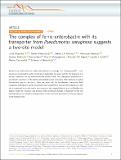Files in this item
The complex of ferric-enterobactin with its transporter from Pseudomonas aeruginosa suggests a two-site model
Item metadata
| dc.contributor.author | Moynié, Lucile | |
| dc.contributor.author | Milenkovic, Stefan | |
| dc.contributor.author | Mislin, Gaëtan L. A. | |
| dc.contributor.author | Gasser, Véronique | |
| dc.contributor.author | Malloci, Giuliano | |
| dc.contributor.author | Baco, Etienne | |
| dc.contributor.author | McCaughan, Rory P. | |
| dc.contributor.author | Page, Malcolm G. P. | |
| dc.contributor.author | Schalk, Isabelle J. | |
| dc.contributor.author | Ceccarelli, Matteo | |
| dc.contributor.author | Naismith, James H. | |
| dc.date.accessioned | 2020-11-17T15:30:20Z | |
| dc.date.available | 2020-11-17T15:30:20Z | |
| dc.date.issued | 2019-08-14 | |
| dc.identifier | 271270654 | |
| dc.identifier | 9a1596e6-04f8-4d6b-bd60-9ed874dea49d | |
| dc.identifier | 85070779528 | |
| dc.identifier | 000480683300003 | |
| dc.identifier.citation | Moynié , L , Milenkovic , S , Mislin , G L A , Gasser , V , Malloci , G , Baco , E , McCaughan , R P , Page , M G P , Schalk , I J , Ceccarelli , M & Naismith , J H 2019 , ' The complex of ferric-enterobactin with its transporter from Pseudomonas aeruginosa suggests a two-site model ' , Nature Communications , vol. 10 , 3673 . https://doi.org/10.1038/s41467-019-11508-y | en |
| dc.identifier.issn | 2041-1723 | |
| dc.identifier.other | Jisc: 504475dcb5814d73956fa63159751fce | |
| dc.identifier.other | publisher-id: s41467-019-11508-y | |
| dc.identifier.other | manuscript: 11508 | |
| dc.identifier.uri | https://hdl.handle.net/10023/20995 | |
| dc.description | The research benefitted from support from ND4BB ENABLE Consortium has received support from the Innovative Medicines Initiatives Joint Undertaking under Grant Agreement nos. 115525 and 115583, resources which are composed of financial contribution from the European Union’s seventh framework programme (FP7/ 2007–2013) and EFPIA companies in kind contribution. This is work is supported by a Wellcome Trust Investigator (100209/Z/12/Z) award. M.C. and S.M. thank the additional financial support of MIUR with the PRIN project 2015795S5W_005. I.S., G.L.A.M., V.G. and E.B. thank also Vaincre la Mucoviscidose and Association Gregory Lemarchal, French associations against cystic fibrosis for additional financial support. J.H.N. and L.M. thank the Membrane Protein Laboratory at Diamond for beam time access. | en |
| dc.description.abstract | Bacteria use small molecules called siderophores to scavenge iron. Siderophore-Fe3+ complexes are recognised by outer-membrane transporters and imported into the periplasm in a process dependent on the inner-membrane protein TonB. The siderophore enterobactin is secreted by members of the family Enterobacteriaceae, but many other bacteria including Pseudomonas species can use it. Here, we show that the Pseudomonas transporter PfeA recognises enterobactin using extracellular loops distant from the pore. The relevance of this site is supported by in vivo and in vitro analyses. We suggest there is a second binding site deeper inside the structure and propose that correlated changes in hydrogen bonds link binding-induced structural re-arrangements to the structural adjustment of the periplasmic TonB-binding motif. | |
| dc.format.extent | 14 | |
| dc.format.extent | 3584358 | |
| dc.language.iso | eng | |
| dc.relation.ispartof | Nature Communications | en |
| dc.subject | QR Microbiology | en |
| dc.subject | DAS | en |
| dc.subject.lcc | QR | en |
| dc.title | The complex of ferric-enterobactin with its transporter from Pseudomonas aeruginosa suggests a two-site model | en |
| dc.type | Journal article | en |
| dc.contributor.sponsor | The Wellcome Trust | en |
| dc.contributor.institution | University of St Andrews. Biomedical Sciences Research Complex | en |
| dc.contributor.institution | University of St Andrews. School of Chemistry | en |
| dc.identifier.doi | https://doi.org/10.1038/s41467-019-11508-y | |
| dc.description.status | Peer reviewed | en |
| dc.identifier.grantnumber | 100209/Z/12/Z | en |
This item appears in the following Collection(s)
Items in the St Andrews Research Repository are protected by copyright, with all rights reserved, unless otherwise indicated.

